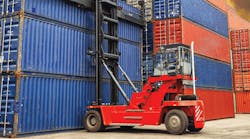One of the unheralded benefits of the government shutdown and the looming debt default is that every other crisis looks a little bit less, well, crisis-ish in comparison. Take, for instance, the latest Shippers Conditions Index, a monthly score compiled by transportation analyst firm FTR Associates, that measures the relative health of U.S. logistics. Two months ago, the index stood at -7.5; last month the index had dropped to -8.1. The current reading has the index dipping even lower, down to -8.3.
So what do those scores actually mean? According to FTR, any score under the baseline of 0.0 means the environment is less-than-ideal for shippers. A reading below -10.0 indicates that conditions are approaching critical levels in terms of extremely tight capacity and expected rate hikes. Under normal circumstances, then, a score of -8.3 would be at the very least a wake-up call to shippers that, “Hey, things are getting pretty tough out there!” But these aren’t normal circumstances, at least the way we used to define “normal.”
“Truck capacity has been able to readily adjust to any increases in demand due to the slow growth environment that has characterized this recovery,” explains Jonathan Starks, director of transportation analysis for FTR. “If freight demand shows any sort of surge over the next few quarters it will become much more difficult for shippers to find the spare capacity to keep operations flowing smoothly. With so little spare capacity in the truck environment at any given time, we believe that rates will be moving higher during the fall peak, and once again during the spring.”
On the flip side, a number of carriers say they plan to add capacity in the third quarter, according to a survey conducted by Transport Capital Partners (TCP). It won’t necessarily be a lot more trucks on the road, but nearly half the carriers polled say they plan to increase capacity by less than 5%.
“The balance between freight and trucks remains tight,” says Richard Mikes, a partner with TCP. “We must face up to the fact, early on, that drivers are truly a brake on truck supply, as well as on truck orders.”
Don’t expect to see much in the way of salary increases to entice more drivers into the industry, though. The TCP study says the number of carriers expecting to raise driver pay dropped from 79% in August 2012 to 66% in August 2013. And even those carriers who are raising wages are doing so very modestly, with 59% saying the increase will be less than 5%.
“Many observers believe higher driver pay is needed to bring more drivers into the industry. But, until shippers are willing to pay more, carriers will be unable to meaningfully increase compensation levels,” Mikes observes.






